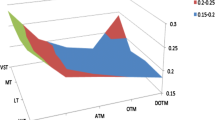Abstract
A number of flexible distributions (generalized beta of the second kind, inverse hyperbolic sine (IHS), \(g\)-and-\(h\), Weibull, Burr-3, Burr-12, generalized gamma, reciprocal gamma) are examined in the setting of option-pricing to explore potential improvements over the standard assumption of lognormal returns. Price formulas are presented specific to each assumed distributional form. The IHS option price formula has not previously been presented in the literature. An empirical application follows where implied risk-neutral density functions for each distribution are estimated from options on the S&P 500 Index. The distributions’ performance relative to one another is then evaluated with the more flexible distributions performing similarly and outperforming their special and limiting cases, including the Black-Scholes which is based on the lognormal.



Similar content being viewed by others
Notes
Equity smiles did not appear until after the 1987 market crash, which created a permanent change in investors’ expectations regarding the potential for large, discontinuous movements in asset prices. See Bates (2000).
Computations involving the CDF of the GB2 and its special cases can be evaluated using programs for the incomplete beta and gamma functions.
See McDonald and Bookstaber (1991).
Milevsky and Posner (1998) use method of moments to estimate the parameters of a reciprocal gamma and price options. Our objective was to compare forecast performance for different distributions using a common estimation method, described in the next section.
Options markets typically are thinly traded and have small open interest or number of contracts relative to the underlying asset markets.
Constant Maturity Treasury rates (CMTs) were used, where the length of maturity was chosen to be closest to the time until the option’s expiration.
A number of optimization algorithms in MATLAB were tested. The objective function (2.26) proved to be ill-behaved with resulting parameter estimates often reliant upon one’s starting location. In an attempt to overcome this difficulty, we perform a grid search, with the optimization algorithm being run starting at each point on the grid for each time period. Although computationally intensive, this method results in more reliable solutions to the minimization problem. The reported results come from the Nelder-Mead simplex algorithm, where the starting point was chosen using a grid search over feasible values for the free parameters.
The \(g\)-distribution can also be reparameterized as a three-parameter generalized lognormal distribution. In light of these results, we considered allowing the \(h\) parameter in the \(g\)-and-\(h\) distribution to be negative. However, many of the corresponding fitted pdf’s were bounded and appeared U-shaped, often rather uniform in shape with vertical asymptotes at the bounds. There was some evidence of increased accuracy, but to compare pdf’s with common general shapes, we restricted our analysis in this paper to \(h\ge 0\).
As a reminder, we define returns as \(S/S_T\). The concern of allowing negative returns is not solved by redefining returns as \(S/S_T-1\), which is similarly bounded below. The GB2 could be translated, but the IHS and \(g\)-and-\(h\) distributions’ domains allow for positive probability below \(-\)1.
References
Bahra, B. (1997). Implied risk-neutral Probability Density functions from Option Prices: Theory and application. London: Bank of England. Working Paper No 66.
Bates, D. (2000). Post-87 crash fears in the S&P 500 futures options market. Journal of Econometrics, 94, 181–238.
Black, F., & Scholes, M. (1973). The pricing of options and corporate liabilities. Journal of Political Economy, 81, 637–654.
Corrado, C. (2001). Option pricing based on the generalized Lambda Distribution. Journal of Futures Markets, 21(3), 213–236.
Dutta, K. K., & Babel, D. F. (2005). Extracting probabilistic information from the prices of interest rate options: tests of distributional assumptions. Journal of Business, 78(3), 841–870.
Dutta, K. K., & Perry, J. (2007). A tale of tails: An empirical analysis of Loss Distribution Models for estimating operation risk capital. Boston: Federal Reserve Bank of Boston. Working Paper 06–13.
Fabozzi, F., Tunaru, R., & Albota, G. (2009). Estimating risk-neutral density with parametric models in interest rate markets. Quantitative Finance, 9(1), 55–70.
Jackwerth, J., & Rubinstein, M. (1996). Recovering Probability Distributions from Option Prices. The Journal of Finance, 51(5), 1611–1631.
Johnson, N. L. (1949). Systems of frequency curves generated by methods of translation. Biometrika, 36, 149–176.
McDonald, J. B., & Bookstaber, R. M. (1991). Option pricing for generalized distributions. Communications in statistics-theory and method., 20, 4053–4068.
McDonald, J. B., Sorensen, J., & Turley, P. A. (2013). Skewness and Kurtosis properties of income distribution models. Review of Income and Wealth, 59(2), 360–374.
McDonald, J., & Turley, P. (2011). Distributional characteristics: Just a few more moments. The American Statistician, 65(2), 96–103.
Milevsky, M. A., & Posner, S. E. (1998). Asian options, the sum of Lognormals, and the reciprocal Gamma Distribution. Journal of Financial and Quantitative Analysis, 33(3), 409–421.
Savickas, R. (2001). A simple option-pricing formula. Working paper, Department of Finance, George Washington University, Washington, DC.
Sherrick, B. J., Garcia, P., & Tirupattur, V. (1996). Recovering probabilistic information from option markets: Tests of distributional assumptions. Journal of Futures Markets, 16, 545–560.
Tukey, J. W. (1997). “Modern techniques in data analysis”, in NSF-Sponsered Regional Research Conference at Southeastern Massachusetts University. North Dartmouth.
Acknowledgments
Financial assistance from BYU’s Office of Research and Creative Activities is gratefully acknowledged, as are helpful comments from Scott Condie, David Babbel, Joe Langsam, Kabir Dutta, Richard Michefelder, Keith Vorkink, and the referees.
Author information
Authors and Affiliations
Corresponding author
Rights and permissions
About this article
Cite this article
Mauler, D.J., McDonald, J.B. Option Pricing and Distribution Characteristics. Comput Econ 45, 579–595 (2015). https://doi.org/10.1007/s10614-014-9441-z
Accepted:
Published:
Issue Date:
DOI: https://doi.org/10.1007/s10614-014-9441-z




